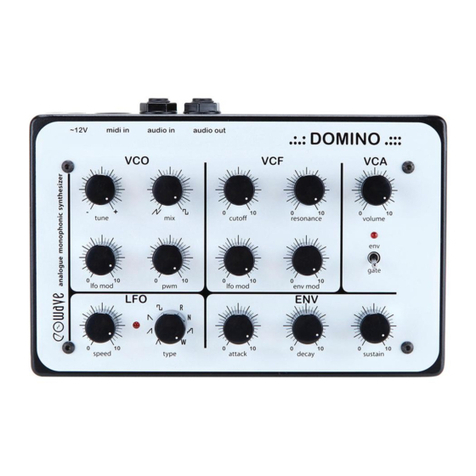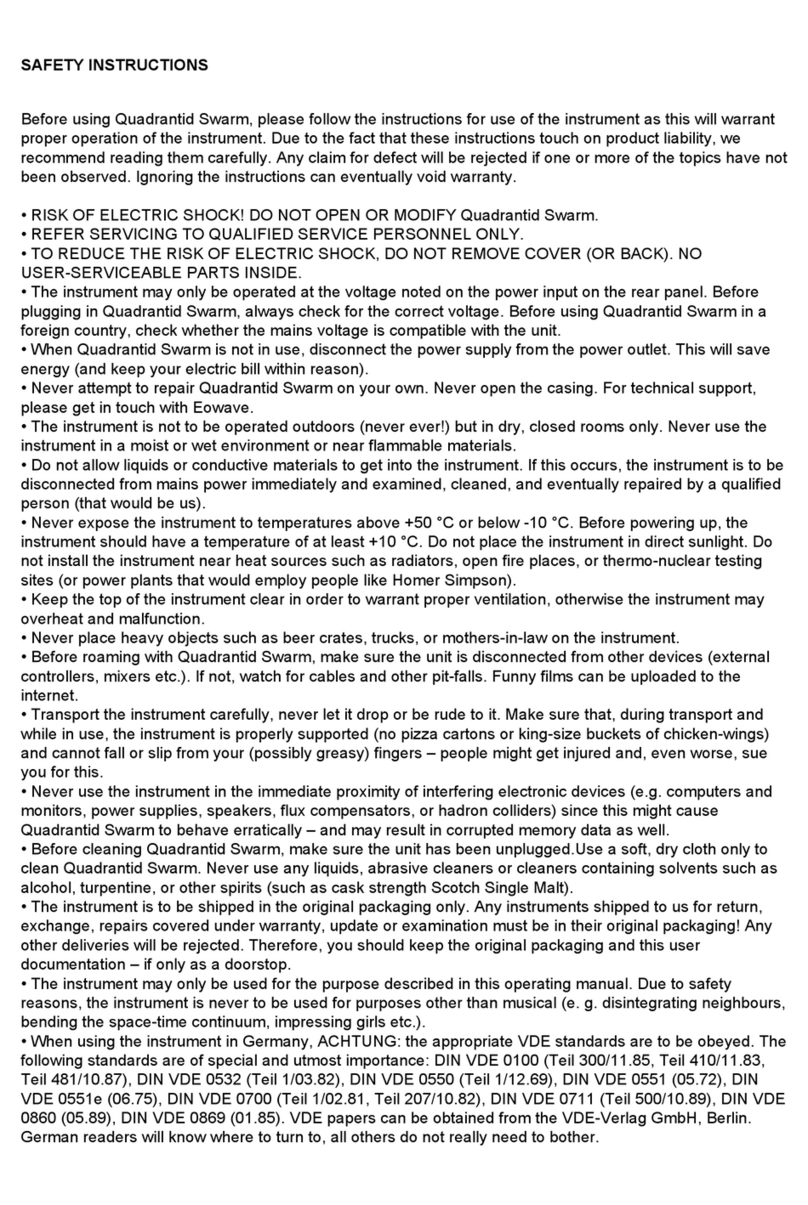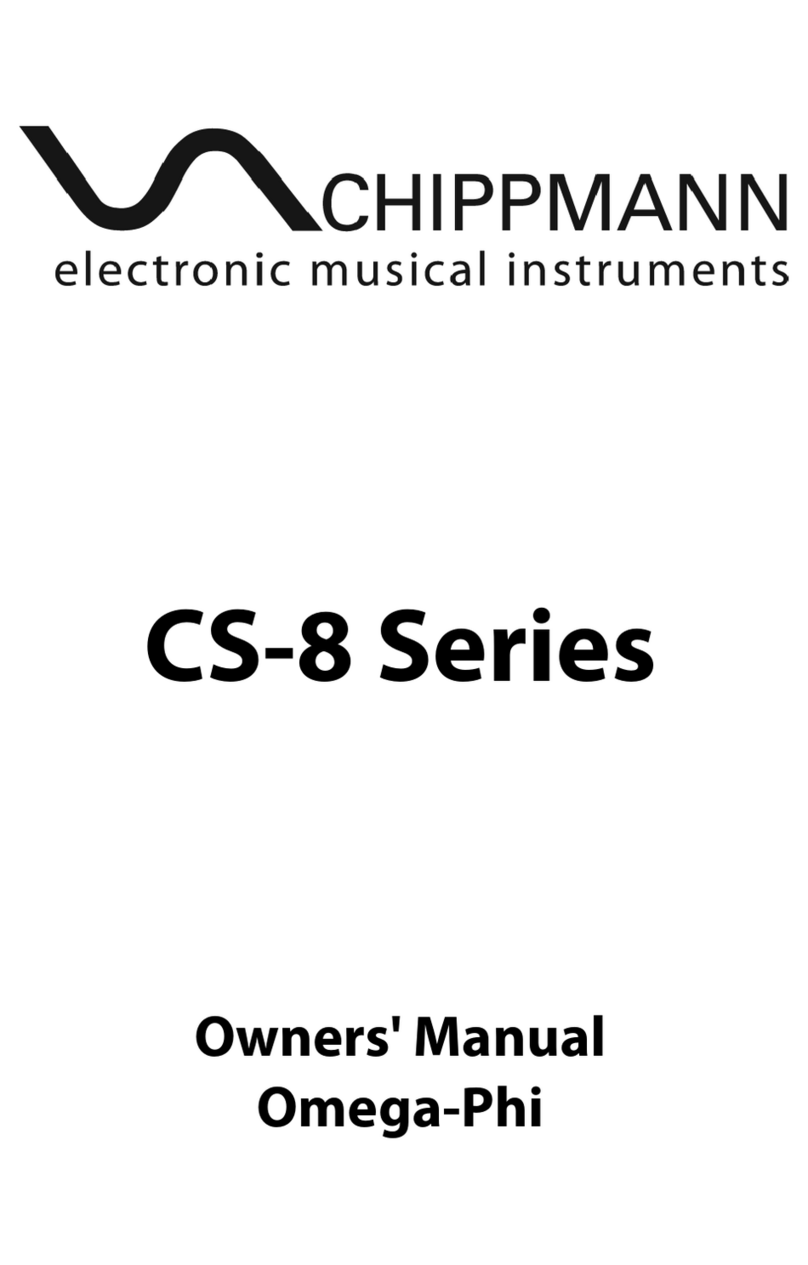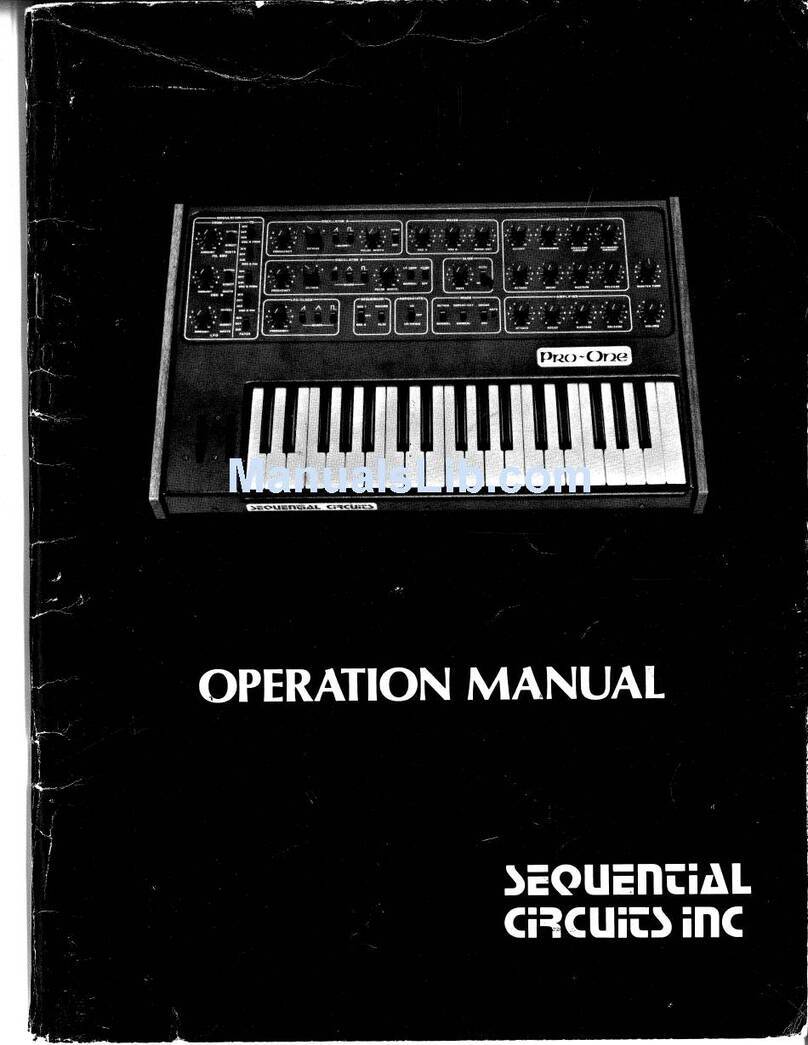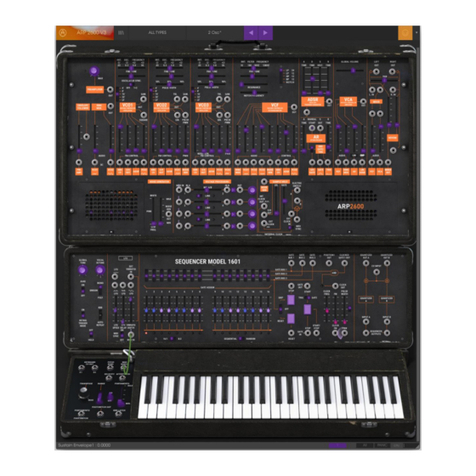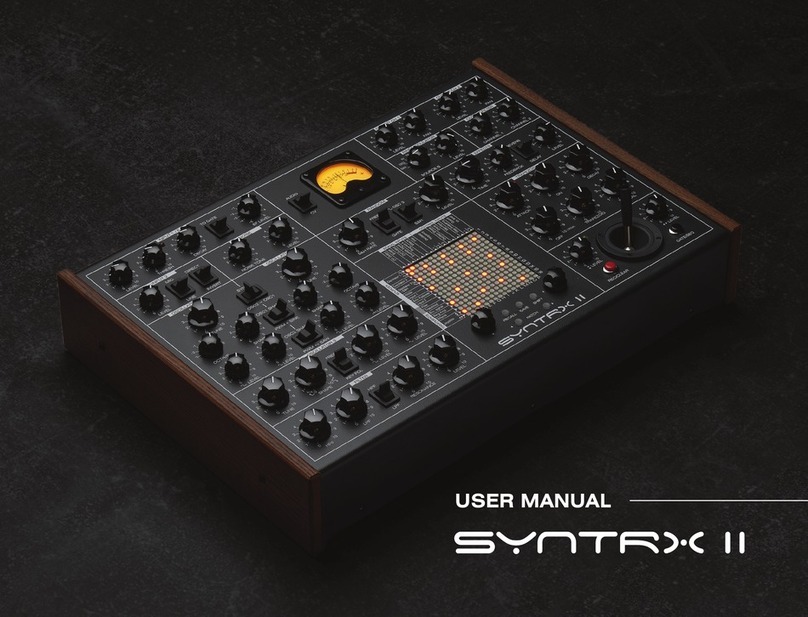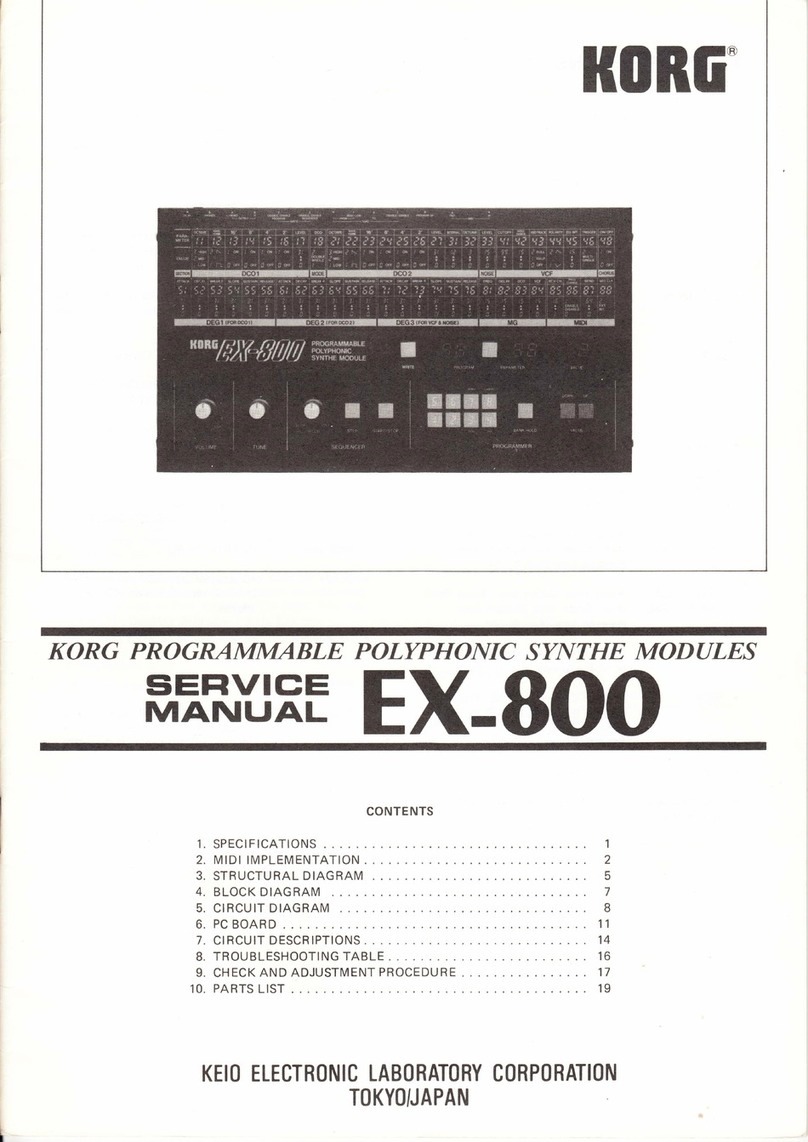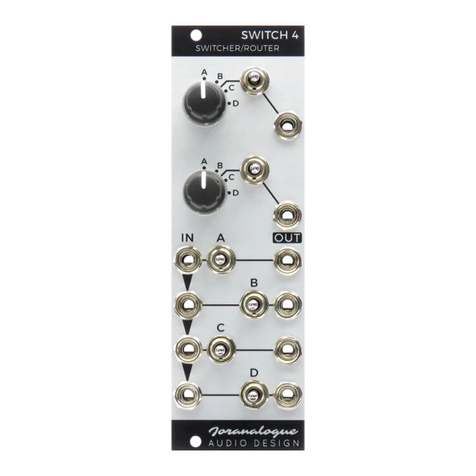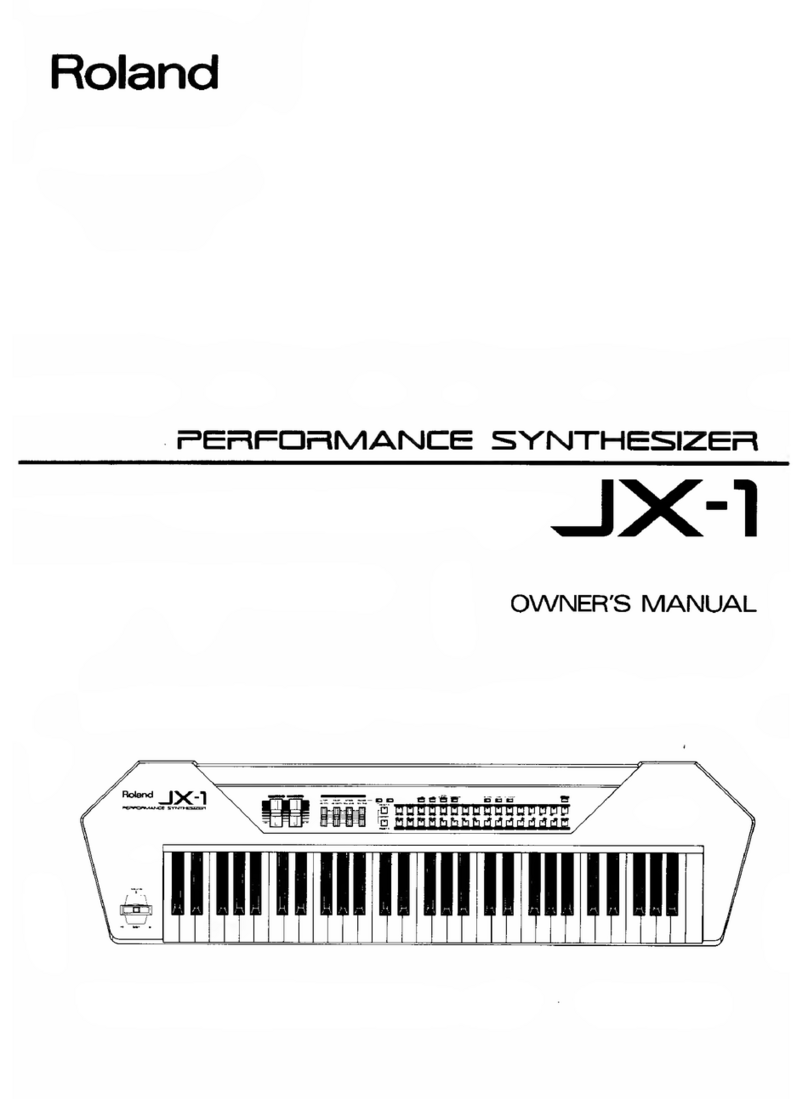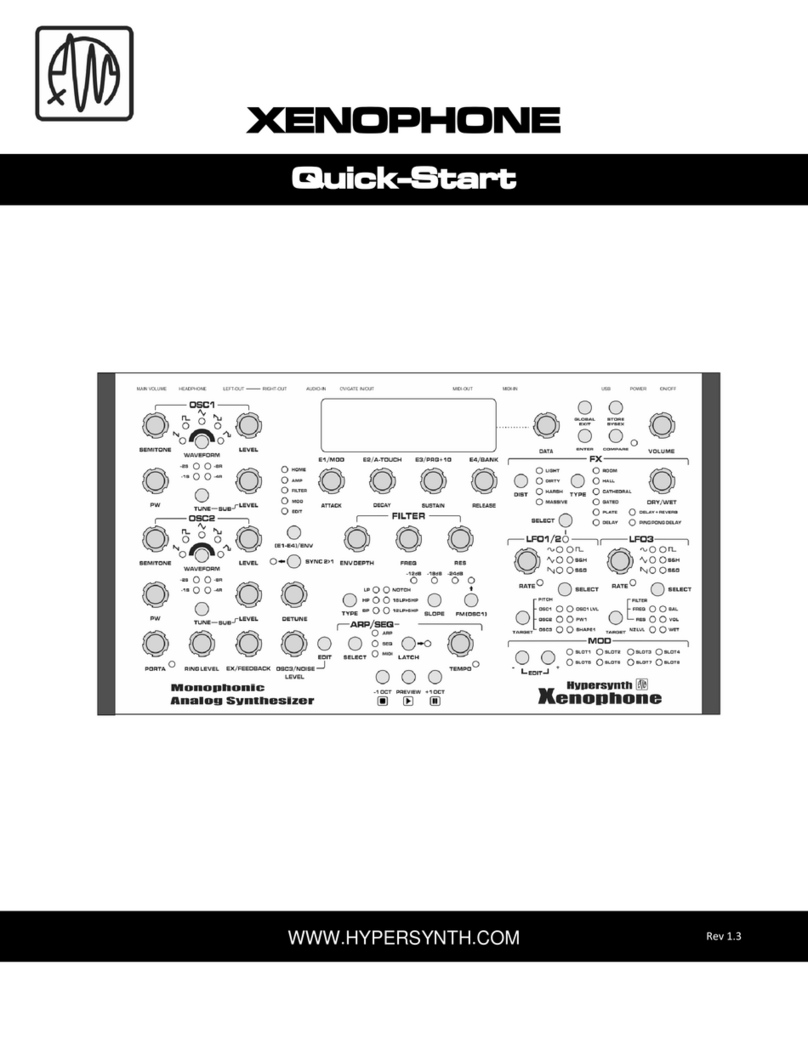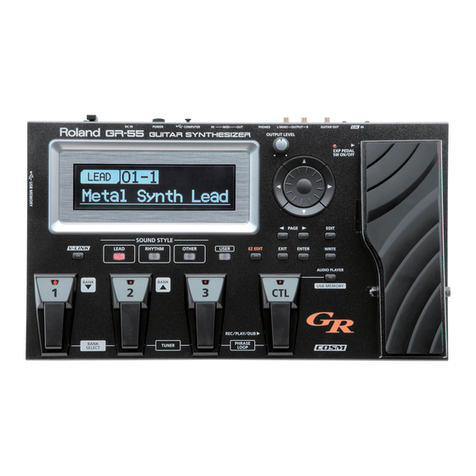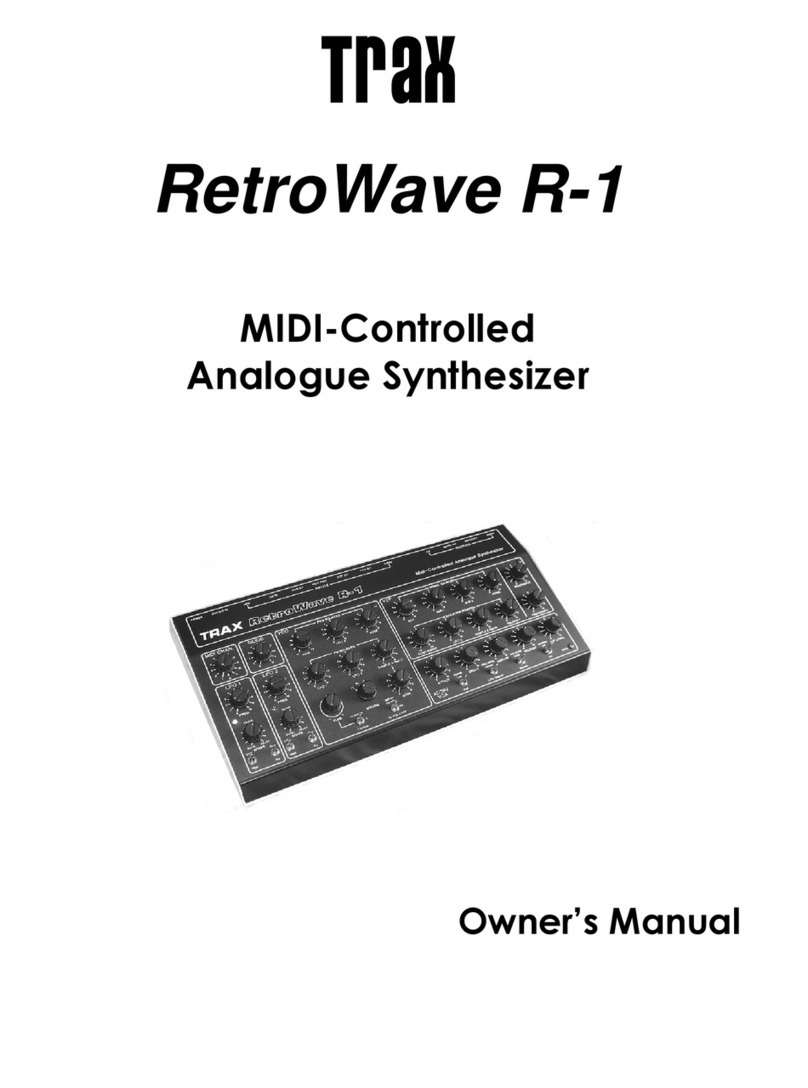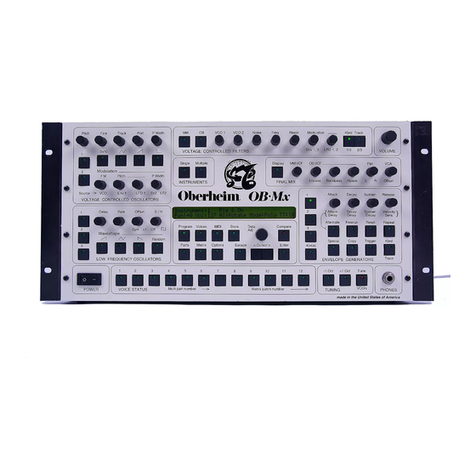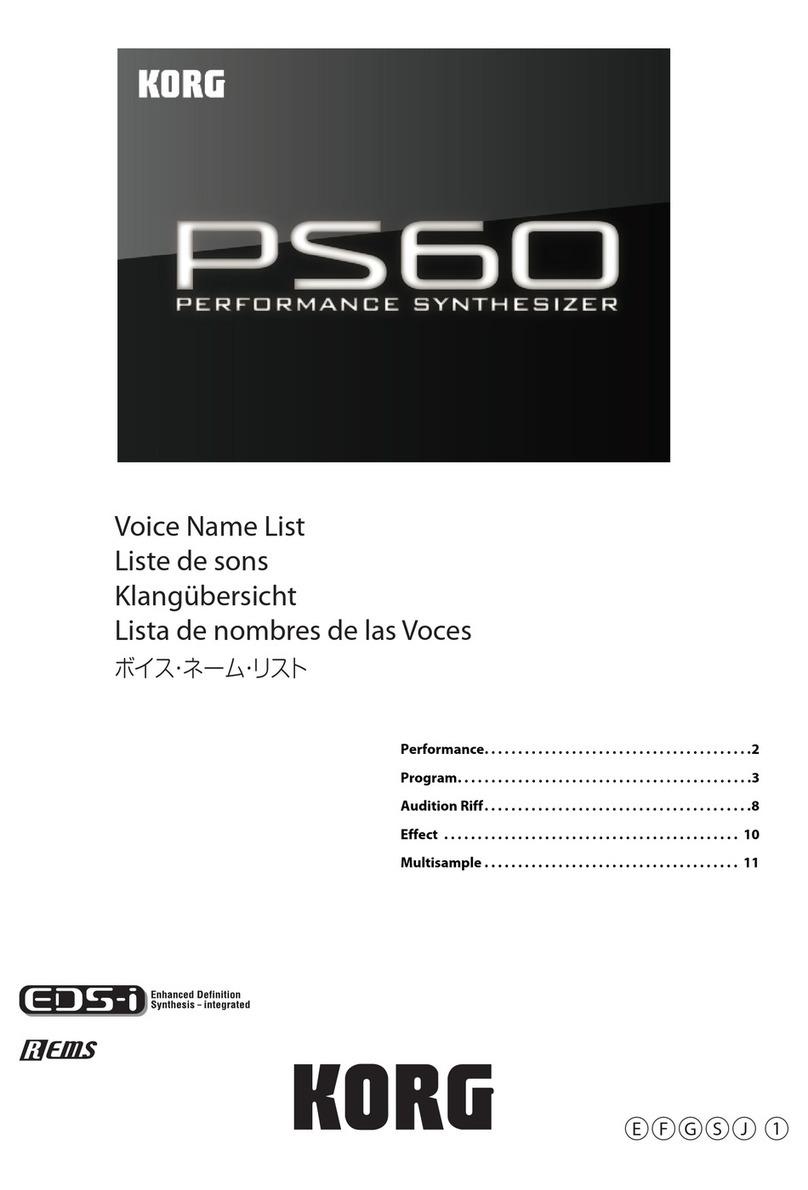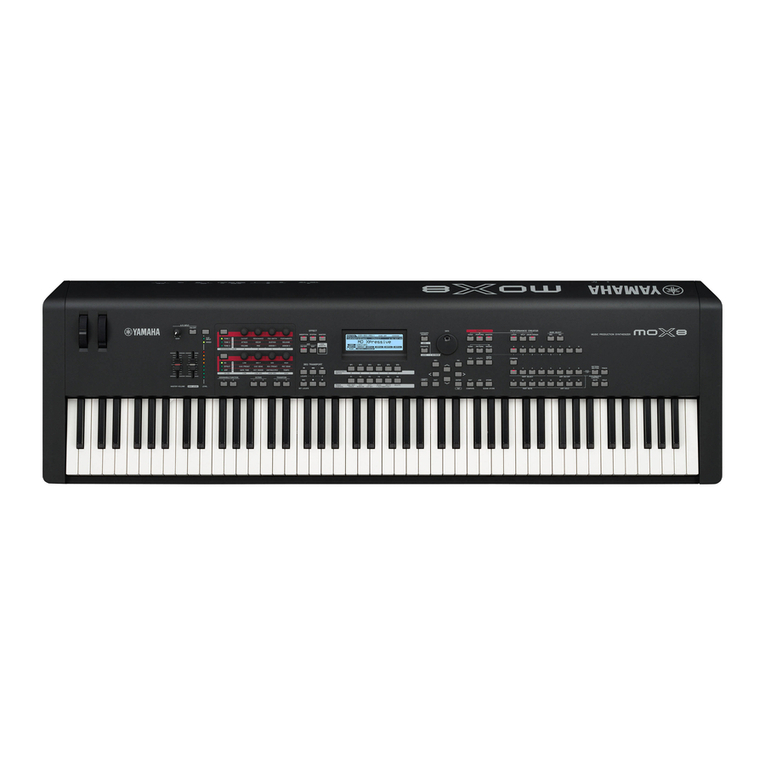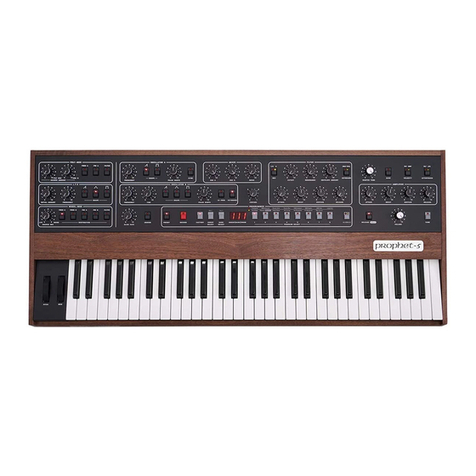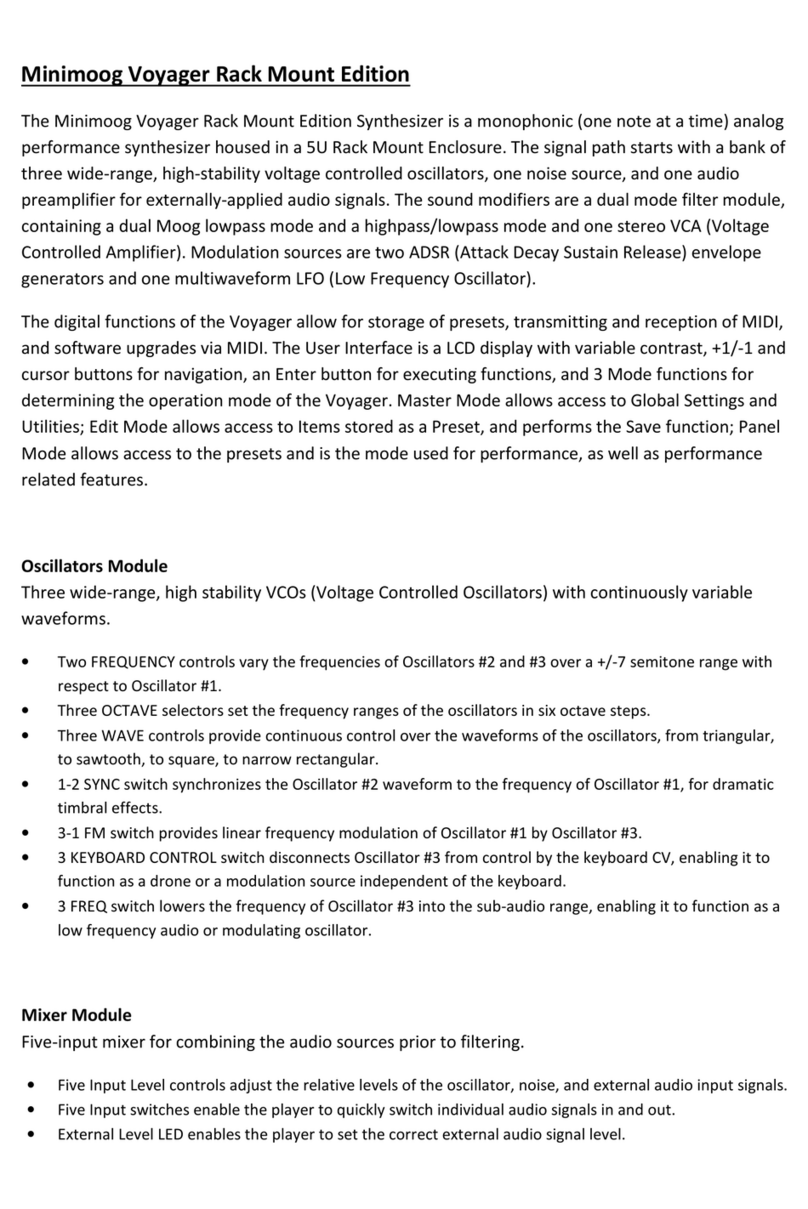Eowave Tempete Magnetique User manual

TEMPÊTE MAGNETIQUE
User Manual
Quad multimode complex filter

2 3
Content :
I. Introduction
II. Installation
III. Block diagram
IV. Overview
V. About normalisation
VI. Inputs & Filters Controls
VII. Series/Parallel & SYNC Switches
VIII. Ping and Envelope Follower
IX. Outputs and Mixing
X. crossmodulation engine
XI. Conclusion
XII. Patch examples

4 5
II. Installation
- Turn o your Eurorack synthesizer system.
- Connect the 10-pin side of the IDC power cable to the 2x5 pin
header on the back of the module, making sure the red stripe on the
power cable is connected to the -12V terminal.
- Connect the 16-pin side of the IDC power cable to the 2x8 pin
header on your Eurorack power supply, ensuring the red stripe on
the power cable is connected to the -12V terminal.
- Install the module in your Eurorack synthesizer case.
- Turn on your Eurorack synthesizer system.
- start making bleeps and blops sounds
Note: This module is equipped with reverse polarity protection, so
it will not be damaged if the power cable is incorrectly installed.
I. Introduction
The Tempête Magnetique is a full analog complex lter/synthesizer mo-
dule that was created as an evolution of the «Fluctuation magnetique».
More than a mk2, we design it to push you to play with one of the most
interesting things in modular synthesis: to divert the primary usage of a
module to create unexpected and new sounds (aka this is not only a lter).
The Tempête Magnétique is deeply inspired by the classical lters design
as well as West Coast synthesis complex oscillators.
At it’s core, has 4 multimode 12db lters that can be chosen to be routed
in series or parallel, which can be used independently or combined and
even crossmodulated, and whose cuto frequencies can be changed
approximately in v/oct or with an integrated envelope follower (which can
be used as an envelope).
The Tempête Magnetique was designed to have several levels of use. The
individual level with the use of separate lters, perfect for quadraphonic
processing of dierent sources (A B C D).
The pair sections which allows for more complex stereo eects or to
generate synthesis voices (X , Y) and nally, the global level with a cross-
modulation of lters.
The independent outputs have been designed to be fed back into their
input, turning them into oscillators ( keep in mind these won’t be really
precise one, but they are approximatly V/oct tuned with they very own
sound). Due to the fully analogical design, these oscillators may have
strange behaviours sometimes, but this instability will bring you the war-
mth of analog gears).
The pairs sections, of course, can lter an incoming signal, But can be
transformed to synthesis voice, percussion engine (exited by the ping
input) and way more.
This lter allows for anything from gentle, subtle ltering to a storm where
the undulations of your sound and their intensity create new types of
textures.

6 7
III. Block diagram
Crossmodulation unit
Set the amplitude of crossmodula-
tion when nothing is plugged to
thec control jack, attenuate the cv
input when a jack is plugged.
Levels of the
internal VCAs
The crossmodulation unit act as a crossmodula-
tor in complex filter. Two internal VCAs send the X
part(A+B output) to the mod Y input and the Y
part( output B+C) to the mod Y input. This work
well when the resonances of filters are high
Amplitude of the envelope
follower modulation
Envelope follower
SENS
Sensibility of the
envelope follower
The envelope follower rectify the signal and
create a modulation who has the shape of the
amplitude, when nothing is pugged to the
follow input, the input A is normalized to it.
Duration of the
envelope follower decay
Enveloppe follower
destination
One of the specificities of the Tempête
is each pole filter is inverting the polarity
of the signal as well as phase shifting
giving its unique character.
Individual output has a phase correc-
tion while summed output takes the
signal as it is internally (phase reversed
at each filters).
Individual Outs Phase correction
PING IN
A+B C+D
IN A
IN C
IN B
Lowpass
Bandpass
Highpass
FILTER A
Lowpass
Bandpass
Highpass
FILTER B
MOD A
MOD B
MOD X
IN C
Lowpass
Bandpass
Highpass
FILTER C
Lowpass
Bandpass
Highpass
FILTER D
MOD C
MOD D
MOD Y
IN A
FOLLOW IN
Select if input B
is normalized with
OUT A (serial)
or IN A (parralel)
Select if input D
is normalized with
OUT C (serial)
or IN C (parralel)
OUT A
INT A
Cut D
INT C
INT C
INT A
INT B
INT C
INT D
INT B INT D
OUT C
OUT B OUT D
IN D
INT A
Cut D
AC
coupling
Ping Trigger
The Ping input transform
gates to small triggers
whose curves has been
shaped to create bongo
style drum
Amplitude of the inputs.
Add some distortion at
some point
Inputs levels

8 9
IV. Overview
1 : signal inputs
2 : signal gains
3 : signal outs
4 : cuto potentiometers
5 : resonance potentiometers
6 : v/oct cuto cv inputs
7 : sync switch
8 : mode selection
9 : lter pair cuto cv
10 : lter pair cuto cv atte-
nuator
11 : parallele /serial switch
12 : summed pair out
13 : enveloppe (follower) input
14 : enveloppe decay
15 : enveloppe follower
threshold
16 : enveloppe attenuators
17 : enveloppe destina-
tion switch
18 : enveloppe led
19 : crossmodulation
amplitude / cv attenuator
20 : crossmodulation cv
21 : ping input
22 :ping led
V. About normalisation
A normalized input is an input on a module or device
that is connected to another specic output by default, unless
another input or patch cable is plugged into the input, breaking
the normalization and allowing the input to receive a signal from a
dierent source. Normalization can be useful for quickly setting up
a basic patch without the need for patch cables, but also allows for
exibility in patching by allowing the user to override the
normalization and patch in a dierent signal if desired.
On the Tempête magnétique, internal normalization is visible
at the jack level with small arrows.
Also, around the jacks, there are symbols that quickly show their
functions. If the symbol is on the left, it means it is an input, if it is
on the right, it is an output,
if it is golden, it is for audio signals, if it is white it is for
modulation signals.
These synbols are for indication, audio and modulation input are the
same kind of signal, we strongly recommend experimenting
to achieve happy little accidents.
AUDIO INPUT AUDIO OUTPUT MODULATION INPUT

10 11
VI. Inputs & Filters Controls
the Tempete magnetique as four 12db (2pôles) lters labeled A, B, C,
and D. Each lter has:
Of course audio inputs (1), the rst audio input of each pair(«IN A» &
«IN C») has a gain potentiometrer(2) who will add some distortion at
some point( it depend to the amplitude of your input signal).
The second input of each pair «IN B» & «IN D» has high gains to
warm it up and make possible the creation of oscillator by feeding
back the outputs to the input.
It will add some saturation to your sound (you can attenuate the
signal if you don’t want it)
«Freq» potentiometers (4) are for adjusting the cuto frequencies
«Reson» potentiometers (5) are for adjusting the resonances levels
A selector switch for each lter allow you to choose between
highpass bandpass and lowpass ltering.(8)
CV inputs for modulating the cuto frequency in approximative v/
oct (6), and individuals audio outputs (3).
Beyond that, the lters can be control by pairs.
The «MODX» and «MODY» (9) inputs control both ot the lters of
each pairs. You can attenuate this input with the corresponding po-
tentiometers (10). When nothing is plugged to these input, They are
used for the crossmodulation engine ( see section VI).
VII. Series/Parallel & SYNC Switches
The serial/parallel switch for each pair of lters (11) allows you to
choose whether the lters are connected in series or in parallel. In
series conguration, the output of one lter is fed into the input of
the next lter, resulting in a more complex and pronounced l-
tering eect. In parallel conguration, the output of each lter is
combined, resulting in a more subtle and less pronounced ltering
eect.
The IN A input is normalized to the IN B (if put in parallel with the
A+B switch) and IN C inputs. The IN C input is also normalized to
the IN D input ( if put in parallel mode with the C+D switch) (respec-
tively). If put in in serial (A>B) the output a is going to the input B
and if (C>D) the OUT C is going in the IN D ( meaning if you plug just
a source on input a, it goes in all the inputs).
The MOD A and MOD C inputs are respectively normalized to the
MOD B and MOD D inputs, these inputs are approximatively in v/oct
In addition to the selector switch and frequency and resonance
controls, lters A and C also have a gain potentiometer who allow
you to add some distortion.
Between each pair of lters, there is a SYNC switch (7) that allows
the right lter to track the cuto frequency of the most left lter
; For example, activating SYNC between lters A and B will cause
lter B to be controlled by lter A. Synced lters has their cuto
shifted a bit to create more warmth. If you turn a synced pot, it will
change a bit the frequency of this one.
Using the SYNC feature in conjunction with the series/parallel switch allows for
even more flexibility in shaping the sound. For example, if all four filters are in
series and in SYNC mode, with each filter being a 12dB/octave filter, you can
create a 48dB/octave filter or two 24dB/octave filters. You can also create
crossover configurations, such as a highpass and a lowpass, to create multiband
processing effects.

12 13
VIII. Ping and Envelope Follower
The TEMPÊTE MAGNETIQUE has an envelope follower input (13)
named «Follow IN». It can be used to modulate the cuto frequen-
cy of the lters in response to the dynamic contours of the input
signal or as a standard AR envelope.
You can use the sens trimmer (15) to modify the sensibility of the
envelope follower and the «DECAY» potentiometer to modify the
decay of the envelope follower (14).
The IN A is normalised to the envelope follower input ( and is inter-
nally ac coupled).
You can choose for each pair (x or y) where the envelope follower is
routed. It can be routed on the second lter of each pair or on both
lters. The led indicator (22) will display the envelope.
Don’t forget to put the «follow» potentiometers fully counter clo-
ckwise if you don’t want to use the envelope follower
The module also has a PING input (21) that transforms a GATE signal
into a trigger. The PING input is normalized to the IN 1, allowing for
easy excitation of the lters.
Since the «IN 1» is normalized to the envelope follower, when you
ping it will excite it and you can use it to create drums.
You can see if you ping with the ping led indicator(18)
These 2 input are reactive to the intensity of the incoming signal.
so you can play with the dynamic by attenuate or amplify your trigg
signal.
(it might seem strange to have only on the second, but it allows you for exa-
mple to create an oscillator with the first filter, put it in serial to the second
and use the envelope filter on this one so you now have a synth voice with
oscillator, filter envelope )
IX. Outputs and Mixing
Each lter as its individual output (3). One these, the phase is re-
verted (since the original topology of the lter reverse the phase we
decided to make these output with the signal corrected).
This phase reversion allow you to feed back the ouputs to the inputs
in order to create oscillators who will have stranges behaviours.
Best to do that is to put the lter in bandpass and the resonance
fully clockwise.
Each pair of lters has an also an output that sums the two lters
(9). The OUT X is normalized to OUT Y , so when nothing is plug to
OUT X , OUT Y act as a sum of all the lters
Internally, the phase of the signal is not reversed so the pair outputs
are the sum of of these lter creating phase shifting and new types
of ltering.

14 15
X. crossmodulation engine
When nothing is plugged on the MOD X or MOD Y inputs , the cen-
tral «MODULATE» crossfader allows you to modulate the frequency
of the X pair with the Y pair output (OUT Y) and the Y pair with the X
pair output (OUT X).
The MOD X and MOD Y potentiometers are here to adjust the maxi-
mum level of modulation,
With the «modulate CV»(20) , you can control the amount of cross
modulation ( if something is plugged to this input, the fader will now
be an attenuator of this input).
Best results when crossmodulating comes when resonance poten-
tiometer are set high ( you can then really ear the lter mooving and
create fm sounds)
If something is plugged into the MOD X or MOD Y inputs the internal
connection between OUT Y and MOD X or OUT X and MOD Y will be
replaced by the incoming signal.
XI. Conclusion
The TEMPÊTE MAGNETIQUE module provides a wide range of lte-
ring options and modulation possibilities, allowing for a great deal of
exibility in shaping the sound of your modular synthesizer system.
Whether you’re looking to create complex lter sweeps, subtle tonal
shifts, or anything in between, the TEMPÊTE MAGNETIQUE has you
covered.
Keep in mind that due to the completely analog design of the
magnetic storm, the lters have slight interactions among them-
selves as well as a bit of noise. We have chosen to leave it as it is
because these minor instabilities are what give this lter its unique
sound. Therefore, it is normal that adjusting one lter may slightly
aect another lter or, depending on the connected outputs, the
behavior may change slightly.
XII. Patch examples
In the following section, you will see some examples of things to
test with the Tempête magnetique.
The position are quite approximative, it is more about the ideas.
Place as shown and tweak the pots to nd your own sweet spots.

16 17
48 db (8 poles) Filter
This one is a huge 8 poles filter when you really want to filter your sound.
Out
Audio
Input
Principle
All the filter are put in serial mode all sync and with the same mode.
put the OUT B in in C so both pair will be in serial too.
With this one, no need to put a lot of resonance since they add up .
You can play with the crossmodulation fader to modulate the filter by
itself.
Mono multiband utility
If you need some simple stereo crossover to treat dierently the high and low
parts of your signal.
Out
IN
Send Low
Send Hi
Return Low
Return Hi
Principle
The first filter pair is configured in crossover mode, with that configu-
ration, you can split a signal in hi and low part, send to dierent
eects, then sum the returned signal in the second part and add
some resonant filtering. ( and even some distortion with the crossmo-
dulation going just in the second pair)
Patch 1 Patch 2

18 19
Sawscillator modulator
create a woobly formant shaper with just a saw oscillator and an attenu-ampllifier
(like the eowave pôle)
V/oct
(same than
oscillator)
Oscillator
(saw) Out R
Out L
Principle
The filter A act as an LFO who is then amplified by an external amplifier
(some attenuator like the Pôle does that) then this LFO is used to
control the crossmodulation amplitude. The filter B is in audiorate
oscillator mode. Both of these filters are modulating the cuto of the Y
pair who is filtering and crossmodulating the saw input. The same
V/oct used for the external oscillator is used to moove the cuto of
the Y pair cuto as well as the X pair so higher you go, faster the LFO
will be. You can tune the B filter to match a ratio of the external
oscillator and play with the A cuto to moove your LFO frequency.
gain X2
if possible
Sine distorder
This one is perfect when you want to createva supra gnarly bass from a sine
Principle
If you input sine an oscillator in the ping input, it will create a smooth
square wave. On the first input who will go to all the filters and the
envelope follower. Play then the Freq, Follow and decay pots and push
the crossmodulate fader to have a shattering teeth filter.
You can use the «OUT Y» as a sum out or both «OUT X» and «OUT Y»
to have a stereo sound.
Out R
Out L
Bass
sine
Patch 3 Patch 4

20 21
kick in the low, hat in the high
With this one, you’ll make the dancefloor bouncing ( or make some kind of ryoji
ikeda stu). It kicks when you trigg on the low and some glitchy hat on the high.
Kick trig
Control CV:
0v= kick
5v=hat
Out
Principle
The Ping input is normalised in IN A so when you ping, it sends an
impulse to in A, but since IN A is normalised to follow in, this allows to
excite the envelope follower. The generated envelope is then applied
to both the X filters put in serial. On the Y pair, you create two
oscillators by feeding back the outputs. This oscillator will be used to
crossmodulate the X section and do some FM on it. Tweak the Y freq
potentiometer to change the texture.
FM Hi Hats
Glitchy percussive hi hat generator
gate in
Accent
modulator
Principle
The X pair is used to create modulators: gate to the ping input so it
activate the envelope follower and put the B filter in feedback
oscillator configuration.
The C filter is used as an oscillator who will be modulated by the Y pair.
This one is going to the D filter who is used to change the dynamic of
the sound with the envelope.
Out
Patch 5 Patch 6

22 23
Blip blop machine
An unstable bleep sound generator using the Tempête self patched
Principle
The B filter is feedback to it’s input to create an oscillator and set yto
the lowest frequency possible( you can even input a negative voltager
to the mod b input to go even lower). This kind of LFO trig the PING
input exiting the filter one and at the same time the enveloppe
follower. On the Y part, both filters are put in feedback too and the X
part LFO is modulating the Y part oscillators. You can play with "modX"
pot to try to find sweet spots in your research of the bleepiest sound
possible.
out
Bongo machine
Bongo machine is a self patch to create a bongo rhythm without any external
device where you can play with the speed of the bongos and their intensity
Out
Principle
The filter C act as a LFO who is going to be filtered by filter D. these are
pinging the bongo part (the X pair) .The cuto of the C filter will
change the speed of the bongo hits. If you put filter D in hipass mode
with low resonance, playing with the cuto around full ccw will
change the intensity of the bongo (since the ping input is sensible to
the amplitude) . If you put it in lowpass with the resonance high (as
shown above) The excitation of the filter D by C will create shued
rhythm. Rise the crossmodulate fader to ad some bubbles
Patch 7 Patch 8

24 25
Crossdistortion
This is made to use if you have two oscillators (best is one for the bass and
another one with the melody.) to add distortion and glue up both synths
together with the crossmodulation engine
oscillator 1
Sub Square
V/OCT
oscillator 1
oscillator 2
(melodic)
Principle
The bass oscillators are inputted on the X pair and the V/oct used for the
oscillator is also used to control the filters cutos. On the Y pair the
melodic higher oscillator is going to filter A with a high resonance to
modulate the bass oscillators filters( if there is harmonics ratio between
bass and melody, it can add some nice saturation). The melodic oscillator
is also filtered by filter D with the envelope on it. And a bit of crossmodu-
lation. This patch requires adjustments depending the oscillators you are
using.You can also use OUT Y as a global output.
oscillator 1
Square
out bass
out hi
Gate
oscillator 2
Patch 9 Patch 10
Stereo full synth voice
An very imprecise but fat and funny complete synth voice
Out R
Out L
Keyboard
Gate
Keyboard
V/oct
Principle
The filter A is used as an oscillator who will track a bit the V/OCT.
This one is going in serial to the B filter which act as an envelope
controlled filter (with an AR kind of envelope). Then, this small synth
voice is going to the Y part where it will be possible to shape the
sound with the crossmodulation engine.

26 27
Principle
Weirdos ducks
These ducks have a pretty serious conversation.
Principle
Who knows ?
Out
Patch 11

Thank you
for
supporting
us
QUADRANTID SWARM
USER MANUAL
EOWAVE
eowave_modular
Table of contents
Other Eowave Synthesizer manuals
